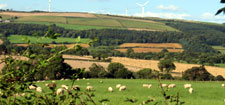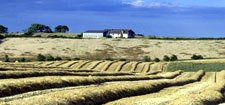Agriculture
The appearance and character of the rural landscapes of County Durham owe much to the way they have been managed by successive generations of farmers. The second half of the twentieth century saw widespread intensification in agriculture under the influence of national and European Community agricultural policies promoting technological progress and productivity. This brought change to many agricultural landscapes, and for most, a decline in the strength of character and diversity of the landscape and a loss of wildlife habitats.
In recent decades the introduction of new legislation and agri-environment schemes supporting farmers in maintaining valued areas of countryside have reduced the large scale loss of habitat and the removal of landscape features. Significant problems remain, however, including overgrazing in some upland areas, a continuing decline of historic landscape features, falling populations of some common farmland species, pollution of watercourses, and ongoing damage to sites of nature conservation value.
The future of our farmland landscapes is likely to be influenced by the growing economic pressures coming from the liberalisation of global markets and increased global demand for both food and bio-fuels, balanced by an increasing emphasis on support for agri-environmental schemes and diversification of the rural economy. It is also likely to be affected in the medium to long term by climate change, which may bring changing patterns of cultivation and new crops.
Issues and Objectives
Agricultural Policy
Under recent reforms of the European Common Agricultural Policy (CAP) agricultural subsidies have been decoupled from production, the Single Farm Payment replacing a range of individual production-based subsidies. The impacts on the character of the landscape of this fundamental change in the nature of agricultural support are difficult to predict at this early stage. Increased resources have been allocated to agri-environment schemes, but again their potential influence on the landscape is not yet clear.
Objectives
- To monitor the impacts of new agricultural support mechanisms on the character of the landscape to inform the development of national policies.
Legacies of the Past
In the uplands of the county, high stocking levels have lead to a decline in the quality of semi-natural vegetation. Across all landscapes there has been a reduction in the species-diversity of pastures and meadows as a result of drainage and reseeding, the use of high levels of fertilisers and herbicides, and the move from hay to silage production. There has been an increase in cultivation in areas of formerly mixed farmland resulting in the loss of older pastures, increases in field size, removal of hedgerows and hedgerow trees and drainage of wetlands.
Many traditional features of the agricultural landscape have also declined through neglect as they have become functionally less important, or costly to maintain. Many hedgerows have become overgrown or gappy – supplanted by wire fences or trimmed low by mechanical flails. Many hedgerow trees planted in the past for farm timber are now reaching the end of their natural lives and are not being replaced by a new generation of trees. Field ponds for the watering of livestock in formerly pastoral areas have silted up or become isolated in the middle of large arable fields. Many old field barns and other farm buildings have fallen into disrepair or been replaced by larger modern buildings.
Restoration of landscape features is only possible or appropriate in some landscapes. In others we must look to the development of new farmland landscapes that meet the challenges of changing economic and environmental forces while respecting landscape character and local distinctiveness.
Objectives
- To encourage conservation, restoration and enhanced management of semi-natural habitats and traditional features of the farmland landscape.
- To promote a ‘landscape-scale’ approach to conservation and restoration works.
- To provide access to information on the character of the landscape to help inform the future decisions of farmers and land managers.
Agri-environmental Schemes
From 2005 pre-existing agri-environmental schemes were replaced by the single Environmental Stewardship scheme, which includes both a Higher Level Scheme (HLS) for specialist management and restoration works and a ‘broad and shallow’ Entry Level Scheme (ELS) to support good environmental management. To be effective these new schemes will need to be responsive to the needs of different landscapes, be integrated with activities across the whole farm, and in some circumstances across the wider landscape.
Take-up of ELS has been fairly widespread in the county, although the number of schemes incorporating HLS has been limited to date. Take-up may be expected to increase as HLS replaces some existing ESA agreements and Countryside Stewardship schemes. There is some concern that HLS will be strongly targeted on important sites like SSSI, leaving a gap in resources available for specialised and capital works elsewhere.
Objectives
- To encourage and facilitate entry into Environmental Stewardship Schemes.
- To monitor the take up of schemes and identify gaps in funding provision.
- To inform the targeting of resources with an understanding of local landscape character.
- To encourage the development of integrated area-based schemes.
- To encourage the adoption of a ‘whole farm’ approach.
Environmental Management
Modern farming techniques have costs to the environment including pollution of watercourses or groundwater and reduction in the diversity of vegetation and wildlife through the use of herbicides and pesticides. Environmental impacts can be reduced by adopting practices like Integrated Farm Management, which integrates beneficial natural processes into modern farming activities using advanced technology, or by adopting organic techniques. New crops and technologies like genetically modified organisms can bring risks to the environment that must be assessed before deployment at a landscape scale.
Objectives
- To encourage the adoption of Integrated Farm Management techniques to reduce inputs and minimise environmental impacts.
- To encourage organic farming and particularly in areas of high environmental sensitivities.
- To encourage the adoption of permanent grassland margins, and /or conservation headlands, around arable fields to buffer hedges and watercourses.
- To resist the introduction of genetically modified organisms unless their environmental effects are thoroughly understood and are acceptable.
Diversification
Diversification of the rural economy is critical to the future of rural communities but brings its own challenges in terms of the scale and types of development appropriate to rural landscapes. The most sustainable forms of diversification are likely to be those which are closely associated with farming and forestry and which do not detract from the rural character of the countryside.
Objectives
- To encourage sustainable forms of farm diversification that respect the character of local landscapes.
- To encourage sensitive design in the conversion of old farm buildings, and sensitive siting, design and screening of new farm buildings.
Climate Change
In the coming decades, climate change is likely to bring new challenges to the agricultural landscape, which may see changing patterns of cultivation or the introduction of new crops. Agriculture itself contributes to climate change, being responsible for about 7.5% of UK greenhouse gas emissions. Food is increasingly transported long distances to markets which contributes further. There are farming techniques such as minimum tillage, improving grassland management and agro forestry which may improve carbon storage. In the long term the substitution of agricultural products for petrochemicals as fuels – such as bio-diesel or biomass – or in manufacturing processes may have a role in reducing CO2 emissions.
Objectives
- To encourage farming systems which minimize inputs, and emissions of CO2 and other greenhouse gasses.
- To encourage local marketing of farm produce.
- To encourage farming techniques which increase carbon storage.
- To encourage the development of energy crops and particularly where they contribute to the enhancement of farmland landscapes
Changing Land Tenure
In recent decades there have been considerable changes in land tenure with an increasing number of both large and small land holdings. This reflects the amalgamation of working farms into larger units and the spread of smallholdings, part-time farms, hobby farms and ‘horsiculture’. An increasing proportion of the countryside is managed by people other than farmers, many of whom lack their expertise and their access to advice and resources. There remains a need for advice and small-scale grants for landscape conservation works which are not provided through mainstream agri-environmental schemes.
Objectives
- To support the provision of advice and financial assistance to the managers of smaller land holdings to promote appropriate management and conservation of landscape features.
Farmland around Towns
Farming in the urban fringe is subject to many pressures including trespass, vandalism and fly tipping. At the same time the proximity of urban populations can bring opportunities for building local markets for farm produce or for diversification into providing recreational or educational services. The promotion and development of a local food economy through farmers markets is already well established in some of the county’s market towns.
Objectives
- To encourage diversification in the countryside around towns where it can bring benefits to local communities and to the urban fringe environment.
- To encourage the production and marketing of high quality local produce and closer links between local farmers, processors, retailers and customers.
- To promote understanding of the countryside generally among urban communities and particularly the young.



